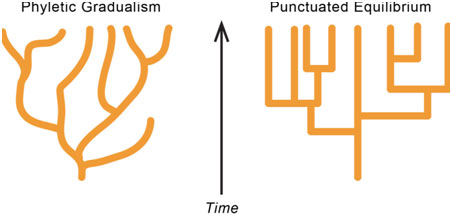Evolution
The changes in species over time are called evolution. Charles Darwin defines organic evolution as “descent with modification”. The modern definition of organic evolution is “the change in frequency of alleles in a population is called evolution”.
Rate of Evolution
It is the measurement of the change over time in evolutionary lineage. It can be quantified as the speed of genetic or morphological changes, overtime in the lineage of life. Mathematically, calculated in terms of proportional change.
There are two models of evolution based on the rate of evolution.

1. Phyletic gradualism
The concept that evolutionary changes occur gradually over millions of years is called phyletic gradualism. Charles Darwin believed in this concept. It is the traditional interpretation of the rate of evolution. However, some evolutionary changes occur very rapidly.
2. Punctuated Equilibrium
Long periods of stasis interrupted by brief periods of change are called the punctuated equilibrium model of evolution. It shows that evolution does not take place gradually. Biologists have observed such rapid evolutionary changes in small populations.
a. Stasis or equilibrium
The periods in which many species do not change significantly over millions of years are called stasis or equilibrium. Stabilizing selection takes place during periods of stasis.
b. Punctuates
The geologically brief period of change is called punctuates. Directional or disruptive selection occurs during periods of change. Stasis is interrupted by an ecological crisis. These ecological crises are generally changes in climate or major geological events.
Some variations are selectively neutral or disadvantageous. But these variations may be advantageous over the next 10,000 to 100, 000 years. New habitats are becoming available due to geological events.

Events that occur in 10,000 to 100, 000 years are almost instantaneous in an evolutionary time frame. This geologically brief period of change is called punctuates as said previously. Then next period of stasis start.
Examples
1. Resistance in Organisms
Insect pests and bacteria acquire rapid pesticide and antibiotic resistance respectively.
2. Finches
Peter Grant studied finches for 20 years. He has shown that natural selection has caused rapid morphological changes in the bills of Galapagos finches. From the middle of 1976 to early 1978, there was long dry period. During this period, finches developed deeper bills.
Before this period, the birds consumed smaller easily cracked seeds. After this, they were forced to turn to larger seeds. Therefore, the birds with weaker bills were selected. Thus, measurable changes occur in the population of finch of the island Daphne Major.
Comparison of Phyletic gradualism and Punctuated Equilibrium
The punctuated equilibrium model has one advantage. The fossil record of punctuated equilibrium does not always show transitional stages between related organisms. Gradualists do not accept an event without transitional forms to fossilization.
But many transitional forms disappeared without leaving a fossil record. Punctuated equilibrium involves rapid changes in small, isolated populations. Thus, preservation of intermediate forms in the fossil record cannot take place.
The rapid pace of evolution causes jumps from one form to another.

